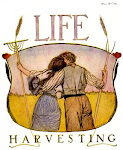The Ideal of Forgiveness, a tale from India. This article appeared here previously on January 15, 2009.
Gopal's Eternal Brother
Once there was a great king named Vishwamitra. One day he learned that there was a saint in his kingdom whom everybody adored. The name of this saint was Vashishtha, and everyone gladly touched his feet. Now, although Vishwamitra was a very great king, nobody used to come and touch his feet.
People were afraid of him, and they would tremble before him. But with Vashishtha it was different. People gladly touched Vashishtha's feet with deepest appreciation and admiration.
So Vishwamitra was extremely jealous of Vashishtha. Vashishtha was a very great saint. After praying to God for many, many years, Vashishtha had realised God, and could speak to God face to face.
Vishwamitra knew that this was the reason why everybody was adoring Vashishtha instead of him, so he too started praying to God.
He prayed to God for a couple of years very seriously, often fasting but still he did not realise God. Then he became impatient. He went to Vashishtha and said, "You have realised God, but I have not been able to. I wish you to tell the world that I have also realised God, like you."
Vashista replied, "How can I say that?" "You can say it," the king insisted. "If you tell people, everybody will believe you, because you yourself have realised God. You know who God is, you speak to God. Tell everyone that I have realised God. Otherwise I shall kill your children!" Vashishtha said, "You can kill my children, but I cannot tell a lie."
Vishwamitra was a most powerful king. One by one he had the hundred sons of Vashishtha killed. The hundred sons were very well educated, kind and spiritual. They had studied the Vedas, the Upanishads and other religious and sacred books.
Nevertheless, the notorious king killed them all. Even after doing this Vishwamitra was not satisfied, because Vashishtha still refused to announce that he had realised God.
After a few months he thought, "This time he has to tell the world that I have realised God, or I shall kill him!" With this idea in his mind he went to Vashishtha's small cottage.
Before knocking at the door he stood outside quietly listening to the conversation inside. Arundhati, one of Vashishtha's wives, was saying to her husband, "My lord, why don't you say that Vishwamitra has realised God? If you had said it I would still have all my children. They were such nice, kind, devoted children.
They were all jewels. But just because you wouldn't say that he has realised God, he has killed all my children, and who knows what he will do next!"
Vashishtha said, "How can you ask me to do that? I love him. He has not realised God. How can I tell people that he has realised God? I love him and that is why I cannot tell a lie."
Even though Vishwamitra had killed the hundred sons of Vashishtha, the father could still say that he loved him! When Vishwamitra heard what Vashishtha said, he came running in and touched Vashishtha's feet, crying, "Forgive me, forgive me, forgive me, my lord. I never knew that anyone on earth could love a person who had killed all his children."
Vashishtha placed his hand on Vishwamitra's head and blessed him. He said, "Today you have realised God, because today you know what love is, what truth is. God is all forgiveness. I am forgiving you, because the God in me is forgiving you. Today you have realised God."
What do we learn from this story? We learn that the ideal of forgiveness is the supreme ideal. When we pray to God, we see God's qualities: love and forgiveness. When we receive love and forgiveness from God, we can behave like God towards other people. Vashishtha's hundred sons were killed, yet even then he loved Vishwamitra.
Then, when Vishwamitra begged for forgiveness, Vashishtha gave it immediately, as well as giving him his inner Light, Joy and Power. Like Vashishtha, we always have the ability to forgive people when they do wrong things.
In this way we give them our Light, our Truth, our Joy. From this story we also learn the importance of associating with holy men.
When we are in the company of a spiritual person, even for a second, what transformation takes place in our life! Our life is changed in the twinkling of an eye.
From Gopal's Eternal Brother And Other Stories for Children by Sri Chinmoy
Mother Teresa, the Venerable: "If we really want to love,
[ our self first, and then the other ] we must learn how to forgive."





